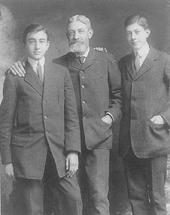|
Carving a Place in the Fox Islands: J Murray Howe II
|
 |
| J. Murray Howe II with sons, A. Murray Howe II and James M. Howe III |
|
|
THE FAR EAST DOWN EAST
By Tina Cohen
One morning last summer, a small group of us sat around a table in front of the Harbor Gawker, crowded under an umbrella for shelter from a hot early-day sun. We were there to talk about art, history, and islands, specifically the Fox Islands and Japan. Those were, not coincidentally, the ingredients in an informative and beautiful book that had just been published. The author, Peggy Howe Ewing, and photographer, Jim Smith, were under that umbrella along with artist Lynn Krauss and me. We were discussing the Japanese-style carvings and painted details installed in some houses built along the Thoroughfare over the years 1886-1920. Peggy’s grandfather was the creative force who built those residences, and he and his work are the subject of that book, Carving a Place in the Fox Islands: J. Murray Howe II (published by blurb.com and available through the website; its cover art happens to feature Howe’s scene of people under umbrellas). This particular morning, we were bemoaning the fact that his art was inaccessible to public view, inside homes, private property. Was it possible to actually display some of those objects? And where better to share them than at the Vinalhaven Historical Society?
Thus, the idea was hatched, to contact Bill Chilles and Sue Radley and see what connection might be made. Other meetings around other tables ensued and came to include the sage Roy Heisler, with support from Lee Howe Howard for fundraising, and Erica Reitmayer as our link to related merchandise. With Jim and Peggy’s hard work in place- their research, inventory, and documentation of the oeuvre-Lynn and I raised our hands simultaneously to the question of curating a show. Yes, we’d be delighted. And here we are now, as I write this in March, anticipating the exhibit’s installation this spring, set to open when the museum does in mid-June.
|
With treasures from Vinalhaven and North Haven on display, the public will for the first time be able to appreciate the amazing Japanesque decoration that has graced some island interiors. Remarkably, Howe was self-taught as an artist and wood carver. His artistry may have had a financial incentive-he thought the ornamentation would enhance the value and appeal of homes for buyers from away; but the designing and carving, done at home in Milton, Massachusetts became a creative undertaking with its own intrinsic satisfaction.
Howe first visited the Fox Islands in 1882, and immediately saw the potential for summer rusticators. With a plan to develop residences along the Thoroughfare for that kind of community; Howe hoped to entice well-to-do Bostonians as buyers. It was the era of industrialization in New England, and those who could afford to escaped their urban environs as often as possible to places less developed, offering clean air and water, open spaces, and peace and quiet. Inside the homes he built or remodeled (nine of which are described in the book) Howe installed, carved and painted decorative details, intensively covering walls, window and door moldings, along with some ceilings and furnishings. They created an unusual ambience, as the designs were derived from pattern books straight from Japan. The texts were obtained from Howe’s father-in-law, Dr. George Rogers Hall, who had spent 1859-1862 developing the Walsh, Hall and Company Trading Business in Yokohama.
Beginning in 1854, following Commodore Perry’s arrival in Yokohama’s harbor, selected ports of Japan opened to Westerners for visits and trade after hundreds of years of exclusion. When Dr. Hall arrived, he was one of the few Americans there; his time in Japan preceded its later popularity as a tourist destination for adventurous New Englanders that began in the mid-1860s. The “curios” brought home from these trips found appreciation among a wide audience. Museums began including Asian art, with notable collections developed in Boston and Salem, Massachusetts. Home interiors boasted vases, dishware, umbrellas, fans, kimonos, and statuary. Dr. Hall had his own assortment, including botanical specimens and books. For Howe, these artistic influences ultimately became translated into his own unique and personalized vision for décor.
What did Howe’s work mean to him? What vision was he realizing? In his transfusion of the Northeast with the Far East, was it metaphysical as well as physical? This summer, come see and consider this for yourself: the art and lore of Howe, the lure of his houses, and the art and allure of the Orient for New Englanders in America’s Gilded Age.
|
|